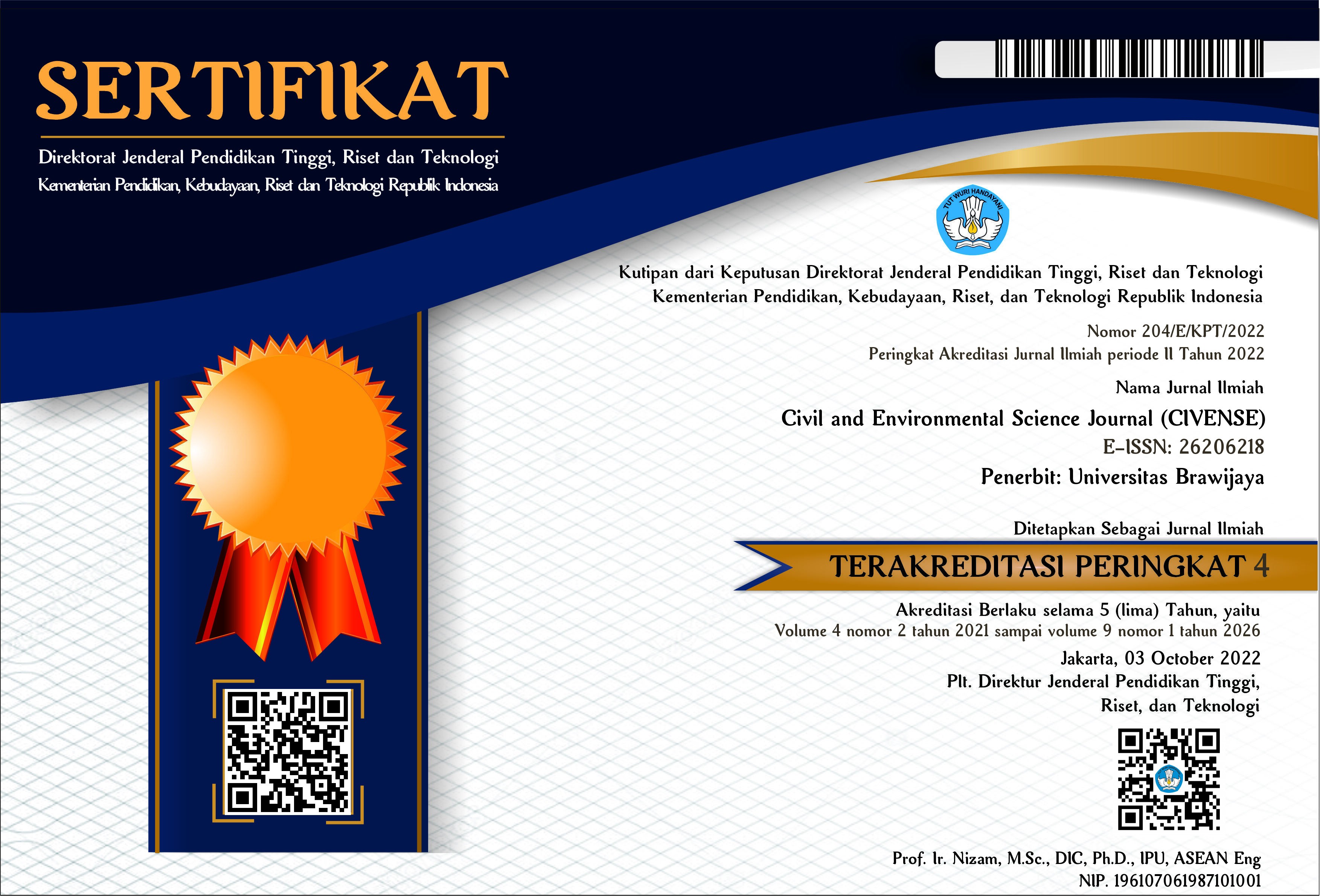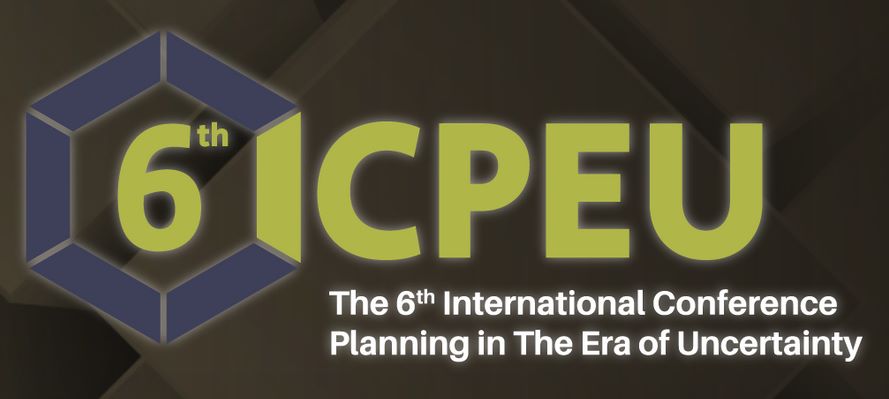Urban Growth Modelling of Malang City using Artificial Neural Network Based on Multi-temporal Remote Sensing
DOI:
https://doi.org/10.21776/ub.civense.2018.00102.2Keywords:
urban growth, artificial neural network, land cover, built-up areas, MOLUSCEAbstract
In this study, the prediction of urban growth was simulated by Artificial Neural Network (ANN) model using MOLUSCE, plugin of QGIS. Objectives of this study is to illustrate the urban growth in Malang City over time span of 24 years and also to predict the future of urban growth using ANN model for the year 2027. Land cover maps were extracted for 2003, 2009 and 2015 via remote sensing images from Landsat ETM+ and OLI, respectively. The overall classification accuracy and kappa coefficient for all classified maps were over 85% and 0.76, respectively. According to the simulation result, 1049.58 ha of vegetation and 241.29 ha of bare land in 2015 would experience a transition to built-up areas in 2027. Then, the built-up areas would experience an increase by 11.79% from 2015 to 2027. In 2027, the built up areas would covered the city by 73.21% of the city area. There was a trend in increasing of built-up areas during the period 2003 to 2027. Overall, the result shows that urban growth models by using ANN model can be a considerable option for future changes according to past and current factors.
References
UN, 2018. World Urbanization Prospects : The 2018 Revision. https://esa.un.org/unpd/wup/publications/Files/WUP2018-KeyFacts.pdf
UN-Habitat. 2013. State of World's Cities 2012/2013. Prosperity of Cities. (Earthscan : London).
Xian, G. Z. 2016. Remote Sensing Application for the Urban Environment (CRC Press: New York)
Bhatta, B. 2012 Urban Growth Analysis and Remote Sensing : Case of Kolkata, India 1980-2010 (Springer : New York)
Lavender S. and Lavender A. 2016. Practical Handbook of Remote Sensing (CRC Press : New York)
Giri C.P.,2012. Remote Sensing of Land Use and Land Cover : Principles and Application (CRC : Press : New York)
Malik, N. 2016. Dinamika Pasar Tenaga Kerja Indonesia (UMM Press : Malang)
USGS. 2016. Landsat Collection - 2016. https://landsat.usgs.gov/sites/default/files/documents/ Special_Iss3_2016.pdf
Tilahun A. and Teferie B. 2016. Accuracy Assessment of Land Use Land Cover Classification using Google Earth. American Journal of Environmental Protection 2015; 4(4): p 193-198
Livingstone D.J. 2008. Artificial Neural Network Method and Application (Humana Press)
Megahed Y., Cabral P., Silva J., Caetano M. 2015. Land Cover Mapping Analysis and Urban Growth Modelling Using Remote Sensing Techniques in Greater Cairo Region—Egypt. SPRS Int. J. Geo-Inf. 2015, 4, p 1750-1769
Araya H. Y. and Cabral P.. 2010. Analysis and Modeling of Urban Land Cover Change in Setúbal and Sesimbra, Portugal. Remote Sens. 2010, 2, p 1549-1563
Vaz E. and Arsanjani J.J.. 2015. Predicting Urban Growth of the Greater Toronto Area - Coupling a Markov Cellular Automata with Document Meta-Analysis. Journal of Environmental Informatics 2015
Ozturk D. 2015. Urban Growth Simulation of Atakum (Samsun, Turkey) Using Cellular Automata-Markov Chain and Multi-Layer Perceptron-Markov Chain Models. Remote Sens. 2015, 7, p.5918-5950
Triantakonstantis D. and Stathakis D. 2015. Urban Growth Prediction in Athens, Greece, Using Artificial Neural Networks. International Journal of Architectural and Environmental Engineering Vol:9, No:3, 2015
Moghaddam K.H. and Samadzadegan F. 2009. Urban simulation Using Neural Networks and Cellular Automata for Land Use Planning. REAL CORP 2009: CITIES 3.0 – Smart, Sustainable, Integrative
Rahman M.T.U., Tabassum F., Rasheduzzaman M., Saba H., Sarkar K.. Derfous J., Uddin S.Z., Islam A.Z.M.Z. 2017. Temporal dynamics of land use/land cover change and its prediction using CA-ANN model for southwestern coastal Bangladesh. Environ Monit Assess (2017) 189:565
Hay S.I., Randolph S.E., Rogers D.J. 2000. Remote Sensing and Geographical Information Systems in Epidemiology (Academic Press: New York)
Downloads
Published
How to Cite
Issue
Section
License
Copyright (c) 2018 Civil and Environmental Science Journal

This work is licensed under a Creative Commons Attribution-NonCommercial 4.0 International License.
Authors who publish with this journal agree to the following terms:
Authors retain copyright and grant the journal right of first publication with the work simultaneously licensed under a Attribution-NonCommercial 4.0 International License that allows others to share the work with an acknowledgement of the work's authorship and initial publication in this journal.
Authors are able to enter into separate, additional contractual arrangements for the non-exclusive distribution of the journal's published version of the work (e.g., post it to an institutional repository or publish it in a book), with an acknowledgement of its initial publication in this journal.
Authors are permitted and encouraged to post their work online (e.g., in institutional repositories or on their website) prior to and during the submission process, as it can lead to productive exchanges, as well as earlier and greater citation of published work (See the Effect of Open Access).














